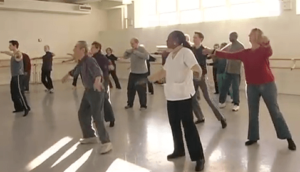Parkinson’s disease affects a person’s ability to move, but this unconventional form of treatment encourages it. Instead of heading to the hospital for yet another prescription medication, Parkinson’s patients can now head to the dance floor.
Olie Westheimer believes that through dance, people who suffer from Parkinson’s disease can better navigate with their bodies and find relief through creative expression. Thus began Dance for PD®, a program in which people diagnosed with Parkinson’s disease, or PD, can come to learn a new dance and better learn how to navigate the world.

Westheimer has been a student of dance for years, and after founding the Brooklyn Parkinson Group, she saw that there was, in fact, a way to combine these two things in a very beneficial way.
“A professionally trained dancer has so much to teach someone with Parkinson’s disease,” said Westheimer, “just at the opposite end of the spectrum. Both have to consider how … to make [their] body move. Dancers just do it exquisitely and persons with Parkinson’s do it to function every day.”
Related: Sitting Too Much Can Speed up the Aging Process
Parkinson’s disease has no known cause or cure. It is chronic and progressive, affecting neurons in the brain that control movement and motor skills. Over time, the symptoms become more and more debilitating, with the person ultimately not being able to control movement of their body. While they remain fully aware of themselves and their surroundings, the brain can no longer send the signals to create appropriate movements.
While dancing may not seem like the obvious choice, there are strong arguments as to why this treatment can encourage PD patients, both physically and mentally.
Westheimer and the Brooklyn Parkinson Group joined forces with the Mark Morris Dance Group to provide dance classes for patients of Parkinson’s, although they are not called patients in classes but rather referred to as students. The disease is not spoken of. All of the classes are run like regular beginner dance classes, with instruction from world-class dancers and performers.
Patients with PD struggle with basic movements, and learning these movements through creative choreography can translate into muscle memory, empowering them to keep active and perform everyday functions. While the movement may be something as simple as extending one’s arm, the dance instructors opt instead to describe the movements in creative analogies, such as throwing “a shooting star.”

While Dance for PD does not claim to cure any of the symptoms, it does provide a way for patients of Parkinson’s to “demedicalize” the disease. The students are encouraged to leave their ideas about movement at the door, as the focus during their class time will be on what they can do, not what they can’t.
Dance for PD now offers classes internationally, and has produced an augmented reality app through Google Glass to provide classes to patients in their own homes.
Related: These Mediterranean Plants May Fight Alzheimer’s and Parkinson’s
Marissa is a health and fitness writer from the Tampa Bay area. In addition to researching the latest trending topics, she enjoys instructing kickboxing classes and posting incessantly to her Instagram account.


![How To: ‘Fix’ Crepey Skin [Watch]](https://cdn.vitalupdates.com/wp-content/uploads/2017/05/bhmdad.png)












